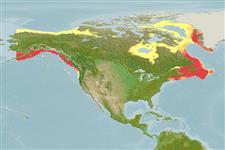Environment: milieu / climate zone / profondeur / distribution range
Écologie
marin démersal; profondeur 0 - 695 m (Ref. 57178), usually 60 - 150 m (Ref. 56557). Temperate; -2°C - 10°C (Ref. 56557); 84°N - 42°N, 162°W - 43°W (Ref. 57302)
Northwest Atlantic: western Greenland and Labrador in Canada to Cape Cod in Massachusetts, USA.
Length at first maturity / Taille / Poids / Âge
Maturité: Lm 10.4, range 10 - 10.9 cm
Max length : 22.0 cm TL mâle / non sexé; (Ref. 56591); common length : 14.2 cm TL mâle / non sexé; (Ref. 56591)
Occurs primarily in the lower sections of the shelf all year (depths of 80-200 m) (Ref. 41410). Inhabits sand and mud bottoms, with temperature range of -1.07 to 2.52°C (Ref. 5951). Feeds on crustaceans and bottom fauna (Ref. 58426).
Life cycle and mating behavior
Maturité | Reproduction | Frai | Œufs | Fécondité | Larves
Robins, C.R. and G.C. Ray, 1986. A field guide to Atlantic coast fishes of North America. Houghton Mifflin Company, Boston, U.S.A. 354 p. (Ref. 7251)
Statut dans la liste rouge de l'IUCN (Ref. 130435: Version 2025-1)
Menace pour l'homme
Harmless
Utilisations par l'homme
Outils
Articles particuliers
Télécharger en XML
Sources Internet
Estimates based on models
Preferred temperature (Réf.
123201): 0.5 - 7.6, mean 4.8 °C (based on 301 cells).
Phylogenetic diversity index (Réf.
82804): PD
50 = 0.7500 [Uniqueness, from 0.5 = low to 2.0 = high].
Bayesian length-weight: a=0.00288 (0.00122 - 0.00683), b=3.07 (2.86 - 3.28), in cm total length, based on LWR estimates for this species & (Sub)family-body (Ref.
93245).
Niveau trophique (Réf.
69278): 3.0 ±0.0 se; based on diet studies.
Résilience (Réf.
120179): Milieu, temps minimum de doublement de population : 1,4 à 4,4 années (Preliminary K or Fecundity.).
Fishing Vulnerability (Ref.
59153): Moderate vulnerability (38 of 100).
🛈
